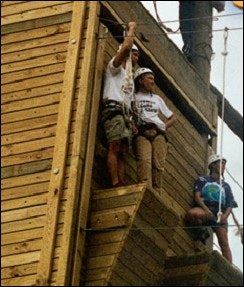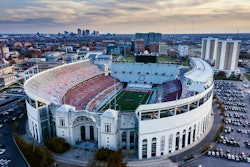Tight Budgets and Changing Clientele Force Campus Recreation Professionals to Do More With Less

"The greatest thing in this world is not so much where we are, but in what direction we are moving."
That statement, made decades ago by former U.S. Supreme Court Justice Oliver Wendell Holmes, speaks to the heart of entrepreneurial efforts in today's college and university recreation programs. Investment in both the construction of large student recreation centers and the sophisticated renovation of existing facilities have made the inclusion of forward-thinking entrepreneurs in campus recreation management positions a must.
For the past 20 years, campus recreation centers have served as the hub of all recreation programs at their respective schools. With the introduction of towering climbing walls, multipurpose activity courts and specialized fitness areas, their place in the center of student life has never been more secure. However, these grand facilities, while an effective student recruitment tool, have nonetheless prompted debate in higher education concerning their cost of construction and operation when weighed against shrinking budgets for academic offerings. Meanwhile, the increase in sports participation by female students as a result of Title IX - combined with the shift in young-adult recreation habits toward nontraditional outdoor adventure activities and extreme sports - compels recreation departments to diversify facilities and programming.
Such developments have made entrepreneurial efforts in recreation administration all the more critical. By diversifying programs and instilling the attitude of doing more with less, campus recreation departments can go a long way toward offsetting operational costs and easing budgetary concerns.
AN ENTREPRENEUR is commonly defined as one who organizes, manages and assumes the risk of a business operation. While the term is often associated with individuals such as Bill Gates, Sam Walton, Oprah Winfrey or Martha Stewart, the entrepreneur label is now appropriate and relevant for many modern campus recreation professionals.
Most people in collegiate recreation agree on the need for large multipurpose facilities, but there is also growing interest in smaller, more entrepreneurial endeavors to meet a variety of specific needs. As a result, skate parks, disc golf courses, challenge courses and multipurpose outdoor field complexes have emerged on several campuses nationwide. For example, Ohio State University's Fred Beekman Park, a $5.3 million outdoor field and park complex, accommodates everything from picnics to rugby practices on three levels of green space surrounded by a lighted biking and jogging trail. Opened in 1999, the 43-acre complex serves 300,000 users annually.
Similarly, the University of California-Irvine took out a bond for $5 million and added $2.5 million in savings from revenue generated from student fees and cost-containment efforts to build a 30-acre outdoor facility featuring four softball fields, six tennis courts, one in-line hockey rink and two basketball courts. UC-Irvine recreation officials justified the construction by pointing to recently revised enrollment projections, which call for the campus of 20,000 to grow by 1,000 students per year until it reaches 30,000.
Entrepreneurialism is an attitude that balances quality service with fiscal responsibility. It establishes an expectation for growth and expansion while focusing on revenue generation and cost containment. Key components of any entrepreneurial project include entrepreneurial spirit, a receptive political environment, a presented or developed opportunity and a sound business plan.
Entrepreneurial spirit is empowering. It promotes risk-taking and fuels creativity. It challenges the perception that recreation programs are mere fun and games. But while entrepreneurial spirit can be a catalyst in creating an environment receptive to change, it is insufficient to gain conclusive results by itself.
The political environment necessary to allow entrepreneurial development is created by actively engaging institutional senior management and student and community leaders in the decision-making process. A receptive and supportive setting is further enhanced by encouraging participation, identifying recreational and personal interests, and presenting a track record of fiscal responsibility. However, like entrepreneurial spirit, a positive political environment alone does not guarantee success.
Opportunity is closely related to political environment and often results from cultivating positive relationships with university and community leaders over time. Opportunities are both created and discovered, and can be developed internally (from within the recreation department) or externally (from outside entities such as the student affairs office or the community at large). It is important, however, to link any opportunity for a project to ongoing institutional or departmental strategic and operational planning initiatives.
Finally, a sound business plan is an indispensable element of any entrepreneurial project. This plan should include projected operational expenses related to personnel and maintenance costs, a plan for capital repair and replacement expenditures, and sufficient revenue to offset all or a portion of these costs.
The benefit derived from the confluence of these factors creates an opportunity for entrepreneurial success.
It's important not to push the revenue button alone, as this often backfires. Subordinates may feel undervalued because their program does not generate revenue. They may even become indignant or self-righteous and attempt to pit the perceived social value of their program against the importance of programs that generate revenue. Thus, the business plan for a proposal should address not only revenue generation, but additional fiscal elements such as cost containment and service bartering. (An example of the latter element would be challenge course staff offering a faculty member the opportunity to become a trained facilitator at no cost in exchange for that person's free or reduced-cost services as a facilitator.) It's important to remember that proposals are not only about the money generated but also about balancing services - both those that are traditional and those that represent new trends - with a businesslike approach to their development and operation.
The Golf and Tennis Center at Ohio University is an example of a politically acceptable, externally created project with a sound business plan. The university had 20 outdoor tennis courts that were scheduled for demolition to make room for various facility expansions. The Division of Campus Recreation, which had built a reputation for operating under sound business practices, offered to develop a tennis complex of six outdoor and four indoor courts. After minimal discussions with senior university officials and planners, division personnel were asked to develop a plan for the construction and operation of the courts. Connecting the tennis facility with the golf course through a centralized clubhouse provided adequate revenue generation through concessions sales and court rentals and a significant cost savings through consolidated staffing to offset a majority of expenses.
Additional revenue was realized from extended use of the golf course outside of normal seasonal operations. Prior to this expansion, golf course operation was housed below spectator stands in the university's football stadium. The remote location restricted control of the course during regular business hours, and single-purpose staffing limited the course to a traditional season - April through October. Consolidating golf course operation and staffing with that of the new tennis facility allowed for better course supervision and the flexibility to open the course on unseasonably warm winter days.
The renovation of Bird Ice Arena at Ohio University is an example of an internally developed project that received special attention at the highest levels of the university and community. Bird Ice Arena was actually a field house prior to its renovation in the mid-1960s. As the region's only ice arena, it has undergone several updates since, including new dasher boards and refrigeration components. At a strategic planning session during the 1999 fiscal year, OU's Division of Campus Recreation identified the need to further renovate the facility to enhance its operations and flexibility. The project proposal was developed at a time when a major renovation was being completed on the Grover Center, an adjacent academic and wellness facility that is home to the College of Heath and Human Services. "University officials were open to facility enhancements that would permit Bird to provide a more attractive street presence and would tie itself architecturally to the newly renovated Grover Center," says Steve Sammons, OU's director of Bird Arena and outdoor facilities and programs. In addition to the exterior and entrance alterations, the Bird renovation included new seating, locker rooms, a pro shop, a skate rental area and a lounge. These areas improved the facility's ability to generate revenue, a key component of the proposed business plan.
As these examples illustrate, entrepreneurial projects are effective if and when they conform to and support the mission and vision of the organization as articulated through a strategic plan. Projects developed outside of a well-conceived planning process create disconnects between the organization's stated mission and its daily operations and may result in a dysfunctional or failed project. To support and enhance connections, criteria for new facility and program proposals should be developed in such a way as to illustrate sustainable growth. By using reserve and carry-forward dollars to develop an outdoor-pursuits program that will eventually generate more revenue than it expends, future surplus dollars can be used to develop new programs and facilities or to offset rising costs relative to non-revenue-generating activities. Program staff members at all levels understand what it takes to get a project approved and can develop proposals that meet established criteria and are given a fair opportunity to make a major impact on the organization's success.
FOR MANY organizations, the proposal criteria include the type and level of service, any experiential learning or professional development opportunities the project will provide, any internal and external collaborations that it may require or engender, and an estimate of the project's fiscal impact.
The type and level of service has and in all likelihood will continue to be a focus of many recreation programs. This is the "what," "why" and the "how well" of a proposal and should restate the type of service desired and how the entrepreneurial effort will enhance the current level of service.
Learning enhancements are fundamental to the basis of any organization. Continual improvement of personnel through continuing education and experiential or service learning opportunities form the foundation for individual and organizational growth and development. By educating organizational personnel, learning enhancements provide the "how can we do it better" part of the operation and stimulate the use of new and innovative technologies.
The synergistic effect of collaboration is quantifiable and a fundamental element of any proposal. In developing the golf course project at Ohio University, grounds and campus recreation personnel were included along with university facility planners in the project planning. Each of these groups contributed either direct project funding or operational support in the form of added services or operational dollars. Tennis center planning included area tennis players and students, as well as recreation programmers, in an attempt to quantify potential revenue and obtain user buy-in during project development. Identification of internal and external partners, potential customers and stakeholders, and what each brings to the project greatly benefits the entrepreneurial effort. This is the "who's responsible" and the "if I win, we all win" part of the proposal.
Finally, identification of the proposal's fiscal impact on the overall operation is a cornerstone in establishing project feasibility. A fiscal impact statement identifies expenses relative to new construction, the outlay of funds for capital equipment and the long-term costs related to these purchases. The statement also includes operational costs, and attempts to identify potential revenue or funds used to offset costs. This is the "how much for how long" part of the proposal.
The Outdoor Pursuits program at Ohio University is a model entrepreneurial effort. The program was initiated with a well-articulated proposal based on a sound business plan outlining significant revenue generation from a variety of income sources. "The proposal had well-defined connections to the stated mission of the Division of Campus Recreation and the Recreation Studies Program within the School of Recreation and Sport Sciences, which enhanced future operational collaborations," says Sammons, program director and developer. "Undergraduate and graduate students are provided exceptional experiential learning opportunities through this synergistic relationship."
Program elements include a resource center, a rental shop, a scuba shop, a trips program and a high-and-low-elements challenge course. Actively involving School of Recreation and Sport Sciences faculty, student leadership organizations and program personnel from continuing education in program planning created excitement and a ready market of future customers. Costs relative to staffing the resource center and indoor climbing wall are offset by revenue from the rental shop and challenge course. "Establishing wholesale and retail relationships with various equipment manufacturers in the rental center and scuba shop has created an opportunity for low-cost new and used equipment sales and rental equipment replacement, and results in significant cost savings opportunities," Sammons says.
An essential element in both the aforementioned key factors and selection criteria is the fiscal environment that supports the viability of entrepreneurial projects. A recreation program that operates in a businesslike environment with sound business principles is more apt to be entrepreneurial and capable of developing these types of projects. Key elements of a favorable fiscal environment include a diverse revenue stream that offsets operational expenses and allows for a minimum of 5 percent to be budgeted as an interest-bearing repair-and-replacement account. Other carry-forward monies, when they become available, should also be moved into this account.
The primary form of funding for many campus recreation programs is the student service or recreation fee. However, continual fiscal success hinges upon diverse revenue streams, including community and faculty facility memberships and program fees, facility rentals, and retail and concessions income. Repair-and-replacement accounts are used for major repairs, the purchase or replacement of capital equipment and to leverage future entrepreneurial projects to generate additional revenue. Consolidation of business-related activities and operations provides cost-containment opportunities, which contribute to an improved bottom line. "The centralized business, marketing and technology department within the division creates an underlying support network that enables departmental personnel to be entrepreneurial," says Rita Mathews, director of business and marketing for Ohio University's Division of Campus Recreation.
Consolidation often includes a centralized system for accounts payable and receivable, payroll, retail and concessions sales, copy and print management, office supplies and consumables, marketing and technology.
ENTREPRENEURIALISM is a force that creates excitement within modern campus recreation programs. It provides the ways and means to exploit opportunities, overcome challenges and provide new and diverse recreation activities for an increasingly changing clientele. It fosters enthusiasm, allows staff to be creative and innovative, and promotes an environment that supports the kind of risk-taking necessary to meet the continual changes in today's modern campus recreation market.




































